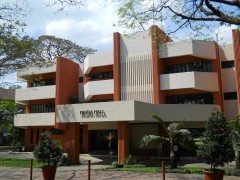Atmospheric Physics
Faculty
Dr. James Simpas
Dr. Gemma T. Narisma
Dr. Nofel Lagrosas
Research Areas
The Atmospheric Physics Laboratory focuses on two main areas of research: environmental sensing and numerical modeling.
Atmospheric Physics Laboratory – The atmospheric physics laboratory is designed to respond to a neglected yet vital area of scientific and environmental research in the country and the Asian region. It is therefore involved in cutting-edge research that has direct environmental relevance in fields such as renewable energy, urban air quality, and environmental instrumentation. While focusing on atmospheric environmental issues, research undertaken in this group has important spin offs such as the development of state-of-the-art environmental sensors, and the building of instrumentation and computational expertise needed in other scientific and engineering fields.
Equipments
Differential Optical Absorption Spectroscopy (DOAS), Mesoscale Model 5 (MM5) and Regional Climate Model (REGCM), LIDAR and Dylec air samplers.
Articles and Book Chapters
P. West, G. T. Narisma, C. Barford, C. Kucharick, and J.A. Foley, 2010: An alternative approach for quantifying climate regulation by ecosystems, Frontiers in Ecology and the Environment, doi: 10.1890/090015.
Beltrán-Przekurat, A., R.A. Pielke Sr., J.L Eastman, G.T. Narisma, A.J. Pitman, M. Lei, and D. Niyogi, 2009: Using the Factor Separation Method for land-use land-cover change impacts on weather and climate process with the Regional Atmospheric Modeling System. In: The Factor Separation Method in the Atmosphere-Applications and Future Prospects, Cambridge University Press, ISBN-13: 9780521191739.
G. T. Narisma, J.A. Foley, R. Licker, and Ramankutty, 2007: Abrupt changes in rainfall during the twentieth century, Geophysical Research Letters, 34, L06710, doi:10.1029/2006GL028628. (Featured in Editor’s pick of the week in Science.)
Pitman A. J., G. T. Narisma, and J. McAneney, 2007: The impact of climate change on the risk of forest and grassland fires in Australia, Climatic Change, 84, doi: 10.1007/s10584-007-9243-6.
Narisma G. T. and A. J. Pitman, 2006: Exploring the sensitivity of the Australian climate to regional land cover change scenarios under increasing CO2 concentrations and warmer temperatures, Earth Interactions, 10, paper no. 7.
Gero, A., A.J. Pitman, G.T. Narisma, C. Jacobson, and R.A. Pielke, 2006: The impact of land cover change on storms in the Sydney Basin, Global and Planetary Change, 54: 57-58.
Pitman A. J. and G. T. Narisma, 2005: The role of land surface processes in regional climate change: a case study of future land cover change over South Western Australia, Meteorology and Atmospheric Physics, 89(1-4), 235-249.
Peel, D., A. J. Pitman, L. Hughes and G.T. Narisma, 2005, The impact of an explicit representation of Eucalyptus on the simulation of the January climate of Australia, Environmental Modelling and Software, 20: 595-612.
Conference Proceedings
GT Narisma, PC West, CC Barford, CJ Kucharick, and JA Foley, A global diagnostic analysis of the relative impacts of land cover change and advection on the local climate, 27th Samahang Pisika ng Pilipinas Phytsics Congress, October 28-30, 2009, Tagaytay City.

